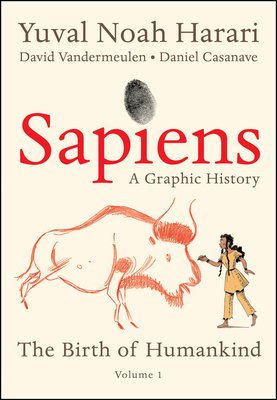Review: Sapiens: A Graphic History, Volume 1 – The Birth of Humankind
When I first immersed myself in Yuval Noah Harari’s Sapiens: A Brief History of Humankind, I was captivated by his ability to weave the expansive history of our species into a compelling narrative. So, when I saw that a graphic adaptation was released, I felt a nostalgic tug and an urge to revisit those insights—especially after a lively discussion in a Facebook group about its suitability for younger readers. Could this visual rendition make Harari’s profound ideas accessible to a 12-year-old? Intrigued, I bumped it to the top of my TBR list.
Adapting a hefty nonfiction work like Sapiens into a graphic format is no small feat, and the creators of this adaptation deserve commendation for their efforts. This first volume focuses on the Cognitive Revolution, effectively breaking down complex ideas into engaging visuals and relatable characters. I was pleasantly surprised by how the addition of dynamic characters brought richness to the narrative. For instance, the inclusion of Professor Saraswati, a saree-clad character who embodies wisdom and warmth, resonated with me and will surely connect with younger Indian readers. She’s not just a character; she’s a bridge between history and the youth of today, making dense concepts feel relevant and digestible.
Now, let’s address the elephant in the room: Is this graphic novel weighty? Yes, it is—largely because it retains the essence of Harari’s original work while distilling it for a different medium. For a young reader who may balk at standard nonfiction, this graphic interpretation is an invaluable stepping stone. The visual storytelling not only enhances understanding but also grounds Harari’s theories in a way that memorizes them without getting lost in academic jargon. However, I do worry that younger readers might take his interpretations at face value, as many of his ideas hinge on speculative assumptions. This is a gentle reminder that, just like the original, one should approach it with thoughtful consideration.
As for the illustrations themselves, they are nothing short of stunning. The finesse in the artwork captures the essence of Sapiens while infusing it with vibrancy. The rich tapestry of characters, experiences, and environments depicted visually makes the book come alive. I found myself thinking, "Who knew history could be this engaging?"
That said, I feel compelled to highlight a couple of points parents may want to consider before sharing this book with their children. There are discussions of adult themes like intimacy and nudity depicted quite subtly. It’s not graphic, but nudity is presented in a few panels, which is a detail parents should be aware of to make an informed choice.
So, should you share Sapiens: A Graphic History with your kids? Ultimately, the decision is highly personal and will depend on a variety of factors: your child’s maturity, interest level, and previous exposure to similar content. The graphic format does provide an inviting pathway to explore humanity’s complex past, albeit cautiously.
Reflecting on my own reading experience, I found this graphic adaptation adds a delightful dimension to Harari’s work that I didn’t anticipate. It made the learning process feel more dynamic and intimate, and I genuinely enjoyed visualizing these monumental concepts alongside a character as relatable as Professor Saraswati.
In conclusion, Sapiens: A Graphic History, Volume 1 – The Birth of Humankind is a fantastic exploration for readers of all ages, especially for those who are visual learners or might feel intimidated by the heft of the original book. If you’re looking for a captivating way to engage with history and human thought, this graphic novel might just be what you’re seeking.
[ad_2]
Discover more about Sapiens: A Graphic History, Volume 1 – The Birth of Hum… on GoodReads >>







